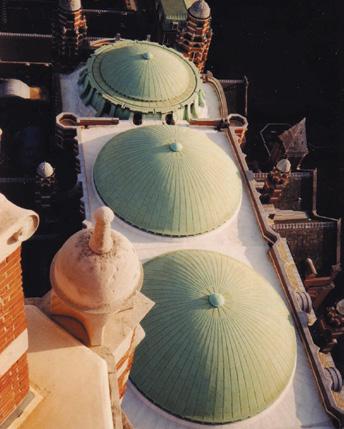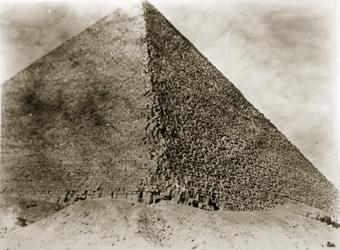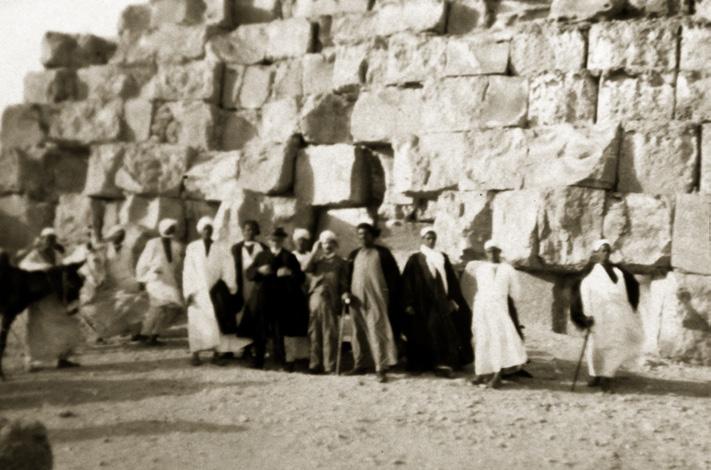
6 minute read
Cathedral History: The Cathedral in Wartime by Patrick Rogers 14
from Oremus June 2022
The Cathedral’s bomb-crater garden in the Choir School playground. June 1944.
for extra priests to go to first aid posts and casualty clearing stations in the event of heavy casualties. Evening Mass had been suspended and the crypt was once again an air raid shelter. The remains of a Westminster City Council notice informing those spending the night there that they were entitled to use council washing facilities for a penny (including soap and towel), rather than the usual three pence, can still be seen on a wall in the crypt store room, despite post-war efforts to remove it.
That was the situation in the Cathedral when the nightly blitz began in September 1940. In October Clergy House was hit, but only by a slab of concrete sent flying by a bomb in Vincent Square. In December it was hit again, ironically by an unexploded anti-aircraft shell which did considerable damage to external brick and stonework before ending up in one of the priests’ rooms. Bombs hit Blocks 10 and 11 of Ashley Gardens in November 1940, and Block 4 in May 1941, shattering windows and scarring the woodwork of Archbishop’s House and the Cathedral Hall, while another bomb, also in May, destroyed a flat on Ambrosden Avenue, breaking many of the large leaded windows in the Cathedral sanctuary and nave, smashing in doors and covering the Cathedral with debris.
Remarkably, the bomb nearest the Cathedral, a delayed action variety which fell in October 1940 and exploded after two hours, left a crater 30 feet deep, 30 feet wide and 30 feet from the Choir School, but did no other damage, even to the windows. The blast was absorbed by the soft clay (the area was originally Bulinga Fen) on which the Cathedral is built, and went up vertically. Bricks and refuse from the Cathedral allotments were thrown into the crater and it was filled with soil over ten months. The Head Sacristan, Mr Hayes, then created a highly ornamental and productive garden, providing 130 pounds of tomatoes annually, together with cabbages, cucumbers, beetroot, onions, beans, parsley, lettuces, peas and mint to supplement the wartime diet, all surrounded by flower beds. Pictures of the Cathedral’s bomb crater garden appeared in the national press and in The Sphere, Tatler and The National Geographic Magazine of America and it featured in the ‘Grow More Food’ campaign on Movietone News.
Beside high explosives, the Germans also used incendiaries, but once again the Cathedral was largely unscathed. When John Bentley, the architect, was 14, his own parish church of St George in Doncaster burned down. In building the Cathedral he used largely fire resistant materials such as brick, stone and concrete on which incendiaries burned harmlessly until extinguished. Nevertheless one burned a large hole in the wood block floor of Cathedral Hall, another went through the roof of the Choir School gymnasium and a third set fire to the hall run by the Catholic Women’s League as a servicemen’s canteen. Another reason for the failure of the incendiaries was a 50,000 gallon static water tank and motor trailer pump in the Choir School playground, which had been provided to protect the Cathedral and the immediate neighbourhood against fire.
All in all the Cathedral was extraordinarily fortunate to survive the 1939-45 War almost unscathed, despite being close to targets such as Victoria Station, Wellington Barracks and many government buildings. A happy, if unintended, consequence occurred after the war. As early as 1918 the domes had been leaking, resulting in the white stains to be seen from the nave. Bomb blasts during the war forced the concrete slabs forming the inner and outer shells of the domes even further apart, resulting in further leaks. In 1948-49, with the help of a grant from the War Damage Commission, the domes were clad with copper sheeting. Over the years this has turned green and is now a particularly attractive feature of the Cathedral. Every cloud has a silver (occasionally copper) lining.

Looking down on the copper-clad domes from the top of the Cathedral tower.
Seeing the Pyramids and Sailing on the Nile
Fr John Scott
The account of the travels in Egypt of my great-great-great uncles Eli and John continues:
But we are anxious to obtain a nearer view of the pyramids and set out at early morning before the sun appeared above the Mokattan ridge. The stranger will now have his first experience of the deceptive character of distances in Egypt. The air is so dry and pure and the plain so level that they do not appear 2 miles away, but the distance is more than 5 and still longer when the waters are out, when the journey may extend to 15. The passage of the river is a risky affair, the rapidity of the current is calculated to excite apprehension when the frail craft destined to convey us across and especially when the crowd of donkeys and men sink the gunwale of the boat almost to the level of the water. In an incredibly short time, we are swept past the island of Rhodato to the opposite bank where we again take to our donkeys. Our approach was not unperceived and a whole force of Arabs soon rushed forward, not to offer, but to force upon us their annoying services.
As in the case of the Falls of Niagara, so it is with these marvels of human creation! It is not until you stand close beneath them that their stupendous magnitude and almost overwhelming grandeur are realised. In looking up at the countless layers of masonry, each of them more than breast high, the mind fails to grasp the fact that they are the result of human effort. It is at the north-

The great pyramid of Cheops At the foot of the pyramid eastern corner that we begin the ascent, where time and accident have somewhat wrought the massive stonework into cracks and fissures. Of these the Fellahs knew every one, and seizing our hands, they rapidly haul us upwards, instructing us in every foothole and shouting, laughing, one pulling us from above, another unceremoniously propelling us in the rear, so that in a short time we stood midway up the giant side of the monument, where we were immediately assailed in loud and threatening tones for Backsheesh. Until this had been liberally paid, further advance was impossible. In ten minutes more, however, we stood upon the summit of this, the most ancient structure of the World.
The view from the summit is wonderful as the building itself. From its crest we look down upon two regions, different as life from death. Far as the eye could see, stretched away the glorious valley, the eternal fertility of which has outlived the Empires founded on and nourished by its prolific soil and everywhere coming up to its green edge and hemming it in with an impassable barrier, are the yellow sands of the Lybian Desert. The second pyramid appears close to in all its grandeur, and at its foot the mysterious Sphinx and a crowd of tombs and pits, the resting places of priests and Nobles clustered round their Monarch. The Sphinx from hence appears insignificant, and the neighbouring group of pylons a tiny speck. On the other side of the river, Cairo looms up as a confused mass, dominated by the Towers of the Citadel and the slender Minarets of the Mosque of the Vice-roys.
The impatience of our half savage attendants leaves little time or opportunity for observation, and we are obliged, reluctantly, to descend. This, to nervous persons, might seem worse than to get up, as they have ever the tremendous perspective of the steps before their eyes; on several occasions, serious and even fatal accidents have happened to travellers who have insisted upon descending without the assistance of the fellaheen. There is little to see in the











